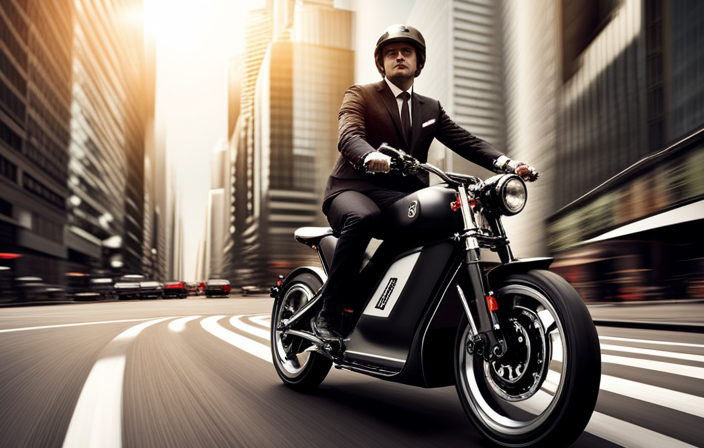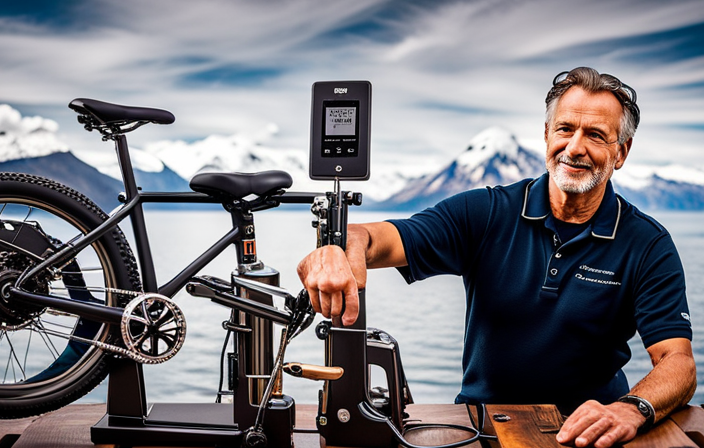I know what you’re thinking – can you really make an electric bike road legal? The answer is yes, and I’m here to show you how.
In this article, I’ll guide you through the steps to ensure your electric bike meets all the necessary requirements to ride on the road safely and legally.
From understanding local road regulations to upgrading your bike’s lighting and braking system, we’ll cover everything you need to know.
So, let’s get started and make your electric bike road legal!
Key Takeaways
- Consult local transportation department or government website for e-bike license/permit information
- Choose and wear appropriate safety gear, including a helmet, knee and elbow pads, and reflective clothing
- Regularly maintain the electric bike to ensure roadworthiness, including checking tire pressure, brakes, and electrical components
- Adhere to speed and power limits to ride legally and safely, avoiding the risk of accidents and penalties
Understand the Local Road Regulations
Before you start converting your electric bike, make sure you understand the local road regulations. Understanding the local road regulations is crucial when it comes to making your electric bike road legal.
Each region has its own set of laws and requirements regarding electric bikes, so it is important to research and familiarize yourself with these regulations. By doing so, you can ensure that your electric bike meets all the necessary criteria to be considered road legal. This research-driven approach will help you avoid any potential legal issues or fines.
Once you have a clear understanding of the local road regulations, you can proceed with confidence in making the necessary modifications to your electric bike, such as installing proper lighting and reflectors to enhance visibility on the road.
Install Proper Lighting and Reflectors
To ensure you’re visible to other road users, you’ll need to install the proper lighting and reflectors on your e-bike. When it comes to choosing the right type of lighting, there are a few options to consider.
LED lights are a popular choice due to their brightness and energy efficiency. They also have a longer lifespan compared to traditional incandescent bulbs. When installing the lights, make sure they are positioned in a way that maximizes visibility from all angles. This means placing a white light on the front of the bike and a red light on the back.
Additionally, reflectors play a crucial role in making your e-bike visible, especially in low light conditions. Position them strategically on the front, back, and sides of your bike for maximum effectiveness.
Add Mirrors for Increased Visibility
When riding your e-bike, it’s important to have mirrors installed for increased visibility. Mirrors placement plays a crucial role in ensuring a clear view of the road and any potential hazards.
The most common types of mirrors used on e-bikes are handlebar-mounted mirrors and helmet-mounted mirrors. Handlebar-mounted mirrors are attached to the end of the handlebars, providing a wide field of view behind the rider.
Helmet-mounted mirrors, on the other hand, are attached to the helmet, allowing the rider to adjust their line of sight by moving their head. Both types of mirrors have their advantages, and it’s recommended to use a combination of both for maximum visibility.
Now, let’s transition into the next section about installing a horn or bell for safety.
Install a Horn or Bell for Safety
Installing a horn or bell on your e-bike is essential for ensuring safety on the road. Not only does it alert pedestrians and other cyclists of your presence, but it can also help prevent accidents by providing an audible warning.
Using hand signals while riding is another crucial aspect of road safety. Signaling your intentions allows other road users to anticipate your moves and reduces the risk of collisions.
When choosing a horn or bell for your e-bike, make sure it is loud enough to be heard in traffic but not overly obnoxious. Additionally, consider the placement of the horn or bell to ensure easy access while riding.
Upgrading the braking system is the next step in making your e-bike road legal.
Upgrade the Braking System
Upgrading your e-bike’s braking system is a smart move for improved safety on the road. When it comes to increasing braking power and improving braking performance, there are several brake system modifications you can consider. Here are three essential steps to upgrading your e-bike’s braking system:
-
Selecting suitable brake components: Start by choosing high-quality brake calipers, rotors, and brake pads that are specifically designed for electric bikes. Look for options that offer increased stopping power and durability.
-
Upgrading to hydraulic brakes: Consider upgrading from mechanical brakes to hydraulic brakes. Hydraulic brakes provide better modulation and more consistent stopping power, making them ideal for e-bikes.
-
Adjusting brake settings: Fine-tuning your brake system is crucial for optimal performance. Adjust the brake lever reach and set the brake pads closer to the rotor for improved responsiveness.
By upgrading your e-bike’s braking system, you can enhance your safety on the road and ensure a better riding experience.
Now, let’s move on to the next important aspect: ensuring the bike meets the maximum speed requirements without compromising its performance.
Ensure the Bike meets the Maximum Speed Requirements
To ensure your e-bike meets the maximum speed requirements, you should check the manufacturer’s specifications and make any necessary adjustments. Maximum speed limits and motor power restrictions vary depending on the location, so it’s important to comply with the regulations in your area. Here is a table outlining the maximum speed limits and motor power restrictions for different regions:
| Region | Maximum Speed Limit (mph) | Motor Power Restriction (watts) |
|---|---|---|
| United States | 20 | 750 |
| European Union | 15.5 | 250 |
| Canada | 32 | 500 |
| Australia | 18.6 | 250 |
Register and Insure your Electric Bike
Once your e-bike meets the maximum speed requirements, you should register and insure it to ensure legal compliance. Choosing the right insurance coverage and taking the necessary steps to register your electric bike are crucial in making it road legal.
To register your electric bike, follow these steps:
- Research the registration requirements in your area, as they may vary.
- Gather the necessary documentation, such as proof of ownership and identification.
- Visit your local DMV or transportation authority to complete the registration process.
- Pay any applicable fees and obtain your registration certificate.
When it comes to insurance, it’s important to select the right coverage for your electric bike. Consider factors such as liability coverage, theft protection, and coverage for personal injuries.
Obtain a License or Permit, if Required
Before you can legally ride your e-bike on the road, it’s important to determine if you need to obtain a license or permit. The requirements for licensing and permitting e-bikes vary by jurisdiction, so it’s crucial to understand the local road regulations.
In some areas, e-bikes are classified as bicycles and do not require any special license or permit. However, in other regions, certain types of e-bikes may require a license or permit, especially if they exceed certain speed or power limits. To find out if you need a license or permit for your e-bike, consult your local transportation department or check the official government website.
Understanding and complying with these regulations will ensure that you are riding your e-bike legally and safely on the road.
Now, let’s move on to the next important aspect: wearing the appropriate safety gear.
Wear the Appropriate Safety Gear
When it comes to making an electric bike road legal, it’s not just about obtaining a license or permit. Another crucial aspect is wearing the appropriate safety gear. Choosing the right helmet and wearing other safety equipment can greatly reduce the risk of accidents and injuries.
Here are two key points to consider:
-
Helmet selection:
-
Look for a helmet that meets safety standards and has a secure fit.
-
Consider additional features like ventilation and visibility.
-
Importance of wearing safety gear:
-
Wearing protective gear such as knee and elbow pads can minimize the impact of falls.
-
Reflective clothing helps increase visibility, especially during low-light conditions.
Transitioning into the next section, it is equally important to regularly maintain and inspect your electric bike for roadworthiness.
Regularly Maintain and Inspect your Electric Bike for Roadworthiness
To ensure your electric bike is safe for the road, regularly maintaining and inspecting it is crucial.
Regular maintenance is important to keep your electric bike in optimal condition and prevent any potential issues that could compromise its roadworthiness. This includes checking the tire pressure, ensuring the brakes are functioning properly, and lubricating the chain.
It is also important to inspect the electrical components of your electric bike, such as the battery and wiring, to ensure they are in good working order.
Conducting a roadworthiness inspection will help identify any potential safety hazards and address them before they become a problem.
Frequently Asked Questions
Can I use my electric bike on any road or are there certain restrictions?
There are certain restrictions when it comes to using an electric bike on the road. It is important to understand the electric bike licensing requirements and adhere to the road rules set for electric bikes.
Are there any specific requirements for the lighting and reflectors on an electric bike?
To make an electric bike road legal, headlight requirements and reflector regulations must be met. For instance, it’s important to have a front headlight that emits a white light visible from at least 500 feet. Reflectors should also be placed on the front, sides, and rear of the bike for increased visibility.
How do I determine the maximum speed allowed for an electric bike in my area?
Determining the maximum speed allowed for an electric bike in my area is crucial to ensure compliance with legal requirements. Researching local traffic laws and regulations, consulting with local authorities, or contacting a transportation department can provide this information.
Is it necessary to register and insure an electric bike?
Yes, it is necessary to register and insure an electric bike in most areas. Electric bike regulations vary, but obtaining an electric bike license, registering the bike, and obtaining insurance are typically required for road legality.
What safety gear is recommended for riding an electric bike on the road?
To ensure safety while riding an electric bike on the road, it is essential to wear proper gear like an electric bike helmet and a safety vest. These items provide protection and enhance visibility, reducing the risk of accidents.
Conclusion
In conclusion, it is crucial for your safety and the safety of others to ensure that your electric bike is road legal. By following the local road regulations, installing proper lighting and reflectors, adding mirrors and a horn, upgrading the braking system, registering and insuring your bike, obtaining a license or permit if necessary, and wearing the appropriate safety gear, you can enjoy a smooth and legal ride.
Just like a well-maintained engine powers a car, these steps provide the necessary fuel to keep your electric bike running smoothly on the road.
Stay safe and ride on!
















